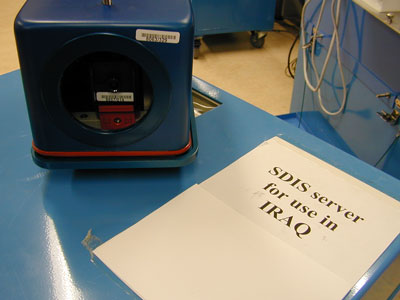Containment, Surveillance, and Monitoring

Tamper-proof and digital video systems are used for surveillance and monitoring at facilities.
(Source:
Dean Calma/IAEA)
The IAEA's safeguards approach for a facility is based on
nuclear material accountancy as a safeguards measure of fundamental
importance, complemented by containment and surveillance (C/S)
measures and monitoring. The most desirable combination of C/S
measures and monitoring is that which permits the safeguards
objectives to be achieved at acceptable costs and with minimum
intrusion into routine facility operations. Monitoring devices may
perform C/S functions, verify the flow of nuclear material items by
counting the items and measuring the amount of nuclear material in
them, or use an attributes test with a 'yes/no' result to ensure
that no movements of radioactive material occur. Monitors are used
in an unattended mode and sometimes with remote data
transmission.
A
|
B
|
C
|
D
|
E
|
F
|
G
|
H
|
I
|
J
|
K
|
L
|
M
|
N
|
O
|
P
|
Q
|
R
|
S
|
T
|
U
|
V
|
W
|
X
|
Y
|
Z
Authentication:
The provision of assurance that a claimed characteristic of an entity is correct.
More.
Containment :
Containers, devices, or structures that are used to prevent undetected access to or movement of nuclear material.
More.
Containment/surveillance device (C/S device) :
Equipment that is used to perform the containment/surveillance function.
More.
Containment/surveillance measures (C/S measures):
The use of C/S measures is aimed at verifying information on movement of nuclear or other material, equipment and samples, or preservation of the integrity of safeguards relevant data.
More.
Containment/surveillance results (C/S results) :
The evaluation of the information provided by a C/S system. An 'acceptable' C/S result is obtained when the C/S device has functioned as specified, its data confirm the validity of the operator's declarations and there is no evidence of tampering.
More.
Electronic optical sealing system (EOSS):
A type of electronic seal commonly used by the IAEA.
More.
Encryption:
Conversion of electronic data or physical data into another form, called ciphertext, which cannot be easily understood by anyone except authorized parties.
More.
Equipment state of health data:
Data on the operating status of equipment and past failures or repairs.
More.
Monitor:
Continuous or periodic measurement of radiological or other parameters or determination of the status of a structure, system or component. Sampling may be involved as a preliminary step to measurement.
More.
Optical surveillance device:
A device used to provide, for later review, a visual record of activities in a defined field of view; it is used to monitor movements of material or handling of equipment under surveillance during the absence of the inspector.
More.
Remote monitoring:
A technique whereby safeguards data collected by unattended C/S, monitoring and measurement systems are transmitted off-site via communication networks for review and evaluation.
More.
Seal :
An indicator that allows personnel to be notified if a device that is used to contain nuclear materials has been accessed by un-authorized personnel.
More.
Surveillance:
Information that is obtained from inspectors and equipment that is used to detect movement of nuclear materials or other items.
More.
Surveillance review system:
The equipment used to review surveillance data obtained by surveillance systems.
More.
Tag:
The unique identifier for an item.
More.
Tamper resistance:
A portion of a device that makes the ability to tamper with and exploit the device, without the probability of being found, more difficult.
More.
Unattended monitoring:
A type of application that is able to run without direct inspector intervention, such as a part of the C/S measurements taken.
More.
Variable coding sealing system electronic seal (VACOSS-S):
The VACOSS seal is a type of electronic seal used by the IAEA.
More.
Vulnerability assessment:
An evaluation of a facility as well as its physical protection system and other systems in place, such as the inventory and categorization of materials. The intent of the assessment is to find gaps and weaknesses that adversary’s may use.
More.